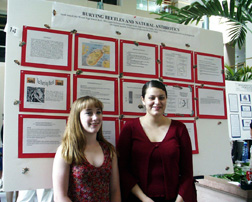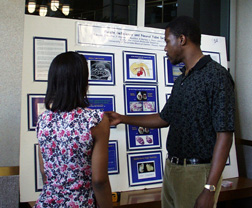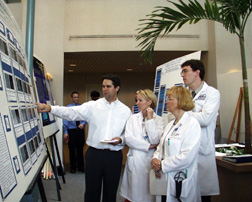 |
Laura Hollingsworth, left, and Sarah Janis with their summer research poster on burying beetles. |
Sarah Janis and Laura Hollingsworth spent the past 10-weeks studying burying beetles to see if they hold the secret to a new antibiotic.
For three hours Thursday, the two showcased their research with more than 50 other undergraduate students in a research colloquium poster session sponsored by the Eppley Institute for Research in Cancer and Allied Diseases. The clinical and basic science research presentations ranged from breast and prostate cancer to congenital defects and kidney and respiratory disease.
“These students spent the summer learning how to do science at a pretty high level,” said Tony Hollingsworth, Ph.D., professor, Eppley Institute, who oversaw the burying beetle project.
Janis, a student at Little Wound High School in Kyle, S.D., and Hollingsworth, the daughter of Dr. Hollingsworth, said results are pending on their project which examined how adult burying beetles keep a carcass from rotting by covering it with oral and anal secretions — presumably with antimicrobial and antifungal activities.
 |
Omar Acres, right, explains his research project to Tasia Hurd. The two Dillard University students spent the past 10-weeks doing research at UNMC. |
Jessica Boro of Omaha, who will be a junior at UNL, worked with cardiologist David Danford, M.D., to evaluate his pediatric cardiology clinical simulation game to determine if the computer-based program is an effective learning tool for medical students and pediatric house officers.
In comparing pre-test to post-test results, Boro said, “preliminary data indicates it may be an effective learning tool.”
“It’s been a phenomenal experience,” she said of the summer research program.
Omar Acres of Dillard University spent the summer studying folate deficiency and neural tube defects, while Sadari Fisher researched Type I diabetes.
“I’ve enjoyed the program,” said Fisher, who will be a sophomore at Dillard University. “It heightens my expectations for next year and gives me more confidence in the lab and in the field of science.”
 |
Levi Ward, a senior at Hastings College, discusses his project on beta tubulin isotype expression in ciliated tissues. |
She is pursuing an 88-hour major in bio/psych/chemistry through Hastings College’s personalized program. “I’d like to go to medical school and be a pediatrician,” she said.
Andrea Gomes, who will be a junior at the University of Nebraska-Lincoln, used microarray technology — which enables researchers to examine the genetic make-up of diseases — to do gene expression analysis of S2-013 tumors. “I eventually want to get into cancer research,” she said.